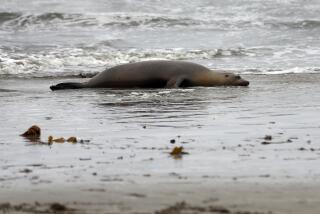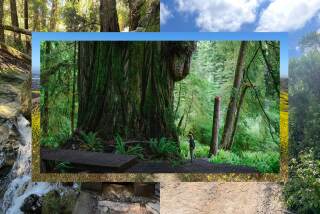Moonlighting on Mono : Kaykers Discover There Is Much to Explore on Eastern Sierra Lake While Drifting Through Stands of Lunar-Like Tufa, Brine Flies and Shrimp
LEE VINING, Calif. â David Umberg couldnât wait to set out on what must have seemed an adventure of a lifetime.
âLetâs go! Canât we go now?â he said, again and again, sitting in his kayak on the beach, having run out of patience almost immediately after arriving at the south shore bof Mono Lake.
His enthusiasm was understandable. Through the eyes of a 7-year-old, Mono could have been the moon.
In the distance, to the east, was a vast and arid, largely barren land wavering under the morning sun.
In the immediate vicinity, towering, craggy spires so alien in appearance that they might have been on the set of a âStar Trekâ movie, reached from both shore and lake, as high as 40 feet. Those on the shore had been exposed by the dropping of the lake in recent years.
These stands of tufa, calcium carbonate structures having evolved over the centuries as a result of a chemical reaction caused by fresh water oozing from underground springs and mixing with the briny, alkaline water in the lake, are the areaâs most visible and awe-inspiring features.
But those about to paddle out into this ancient lake, including young Umberg and his younger sister Jennifer, 4, and their parents, Greg and Linda, would learn that there is much more to Mono Lake than its tufa, that it is not âCaliforniaâs dead sea,â as Mark Twain once described it and as it appears to be from the scenic viewpoint on U.S. 395.
âThereâs no other place like it on Earth,â said Laura Maltbie of the Mono Lake Committee, an organization dedicated to the preservation of the lake. âMost people come to the Eastern Sierra and think trees and forests and meadows. Then they come to Mono Lake and see it is surrounded by sagebrush and you have all these weird formations.â
Standing amid the tufa, ankle deep in flies, which blanket the wet grasses along the Mono Lake shore, the Umbergs were briefed and ready to push off. They did, leaving the flies behind.
Ed Johnson of Mariposa, Randy Robinson of Fresno, Brian Deller and Tara Bailey of Sebastopol, as well as several others got underway as well, setting a course for barren Paoha Island, a large volcanic, silt-laden land mass three miles away.
Guide Stuart Wilkinson, who runs Caldera Kayaks from his home in Crowley Lake, is among those who believe that although Mono Lake is too salty and has too high an alkali content to support fish, it has a lot to offer visitors to the Eastern Sierra.
Backed by environmental groups, they have fought hard over the years to save the lake from a thirsty city some 300 miles to the south.
The Los Angeles Department of Water and Power for decades has diverted most of the water from the five creeks that feed the embattled lake, which until the heavy precipitation last winter had dropped more than 40 feet below its historic level.
No streams flow from Mono Lake, which means that water escapes only by evaporation. This leaves behind whatever minerals the water carries in, which accounts for the lakeâs salinity. But without fresh water coming in because of the diversion, Monoâs salinity content increased to the point where the fragile ecosystem, believed to be more than a million years old, was seriously threatened.
Environmentalists only recently were able to win key court battles, which last year resulted in a mandate that Los Angeles stop diverting the creeks until the lake is returned to a certain level, and that any future diversions may not drop the lake below that level.
This came as good news to environmentalists, or anyone concerned with what was happening to Mono Lake.
The Mono Lake Committee offers hourlong, narrated canoe trips among the tufa towers of the south shore in an effort to promote understanding of the lake.
Wilkinson has taken it a step further, offering daylong kayak trips that, when weather permits, take people to Paoha and back.
âIâve been kayaking up here quite a while,â he said. âNobody else was doing it; itâs a good recreational opportunity; I saw kayaking booming in the state, and the whole country for that matter, so I thought, âWhy not?â â
Setting a course for the island, talking as he paddled, Wilkinson said the little critters are only harmless brine flies, and in fact were considered a delicacy by native Americans who inhabited the region. The word mono, in the Yokut Indian language, means fly people .
Then his customers immediately encountered other little critters that thrive beneath the surface of a lake that Wilkinson said is three times saltier than the ocean.
Brine shrimp, almost microscopic in size, fluttered about by what seemed millions, being stirred by the paddlersâ every stroke.
Estimates place their number at an astonishing 4 trillion, with a relatively small percentage--about 200 tons--being harvested each year for use as fish food in aquariums.
So thick are the shrimp, which graze on algae, that one ranger likened the lake to a huge bowl of soup. Another said it was like a great big gas station for migrating fowl.
Eared grebes, small duck-like birds, arrive by the thousands in midsummer from western Canada and stay about four weeks before flying south to Baja California. Phalaropes, sandpiper-like birds, also arrive in midsummer, from the arctic tundra, and stay about six weeks, putting on an ounce or two before their long journey to South America, where they spend the winter.
California gulls come in late March and early April, and stay about two months, breeding and feeding. It is estimated that about 50,000 gulls, or about 90% of the stateâs nesting population, nest at Mono Lake each year. Which means that 90% of the gulls soaring over West Coast beaches were hatched at Mono Lake.
Paddling over the lakeâs placid surface, the kayakers could see for miles in either direction: the barren desert and its mirages to the east, and the majestic Sierra and its still snow-capped peaks to the west.
Amid them there were no other boats, only birds, large and small, bobbing and diving, some watching the kayakers.
Finally, the paddlers reached the island. Remnants of a chicken ranch were visible up from the beach. Homesteaders lived on the island briefly after the turn of the century, and a sanitarium was built there not long after that.
Now the island, which has no coyotes or other predators, belongs to the birds. And, occasionally, to kayakers such as Wilkinson and his customers.
Arm-weary from their long crossing, and encrusted with salt, they stepped out of their kayaks and walked up to a chalky bluff on the beach, where they sat and ate lunch, gazing around as if they had just landed on another planet.
More to Read
Sign up for The Wild
Weâll help you find the best places to hike, bike and run, as well as the perfect silent spots for meditation and yoga.
You may occasionally receive promotional content from the Los Angeles Times.






